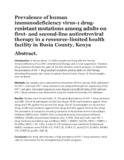Prevalence of human immunodeficiency virus-1 drug-resistant mutations among adults on first- and second-line antiretroviral therapy in a resource-limited health facility in Busia County, Kenya
Date
2020-12-03Author
Makwaga, Olipher
Adhiambo, Maureen
Mulama, David Hughes
Muoma, John
Adungo, Ferdinard
Wanjiku, Humphrey
Ongaya, Asiko
Maitha, Geoffrey Mutisya
Mwau, Matilu
Metadata
Show full item recordAbstract
Introduction: in Kenya, about 1.5 million people are living with the Human Immunodeficiency Virus (HIV). Antiretroviral therapy aids in viral suppression. However, drug-resistance threaten the gains of the HIV infection control program. To determine the prevalence of HIV-1 drug-resistant mutations among adults on ARV therapy attending Khunyangu sub-county hospital in Busia County, Kenya, 50 blood samples were analyzed.
Methods: the samples were collected from November 2019 to January 2020 and tested for HIV-1 viral load. HIV-1 drug-resistance was analyzed through the sequencing of the HIV-1 pol gene. Generated sequences were aligned using RECall (beta v3.05) software. HIV-1 drug-resistance was determined using the Stanford University HIV database.
Results: females were 34 and males 16. The general prevalence of HIV-1 drug-resistance was 68%. Out of 34 participants on first-line drugs, 59.9% had mutations against these drugs and 5.9% against the second-line drugs. Out of 16 participants on second-line drugs, 43.8% had mutations against these drugs and 50% against the first-line drugs. The prevalence of mutations encoding resistance to Nucleotide reverse transcriptase inhibitors (NRTIs) were 23(46%); Non-nucleotide Reverse transcriptase inhibitors (NNRTIs), 29(58%) and protease inhibitors (PIs), 7(14%). Dual and multi-class HIV-1 drug-resistance prevalence was as follows: NRTIs + NNRTIs 16(32%); NRTIs + NNRTs + PIs 4(8%); NRTIs + PIs 1(2%). A total of 126 mutations were identified. Predominant NNRTIs mutations were K103N (15), Y181C (9), G190A (7), and H221Y (6) NRTIs, M184V (17), Y115F (5) and PIs, I54V (4).
Conclusion: the study demonstrates a high prevalence of HIV-1 drug-resistance which calls for intervention for the strengthening of health programs.
URI
https://doi.org/10.11604/pamj.2020.37.311.25909https://www.panafrican-med-journal.com/content/article/37/311/full/
http://ir-library.mmust.ac.ke:8080/xmlui/handle/123456789/1915
Collections
- Gold Collection [1026]

